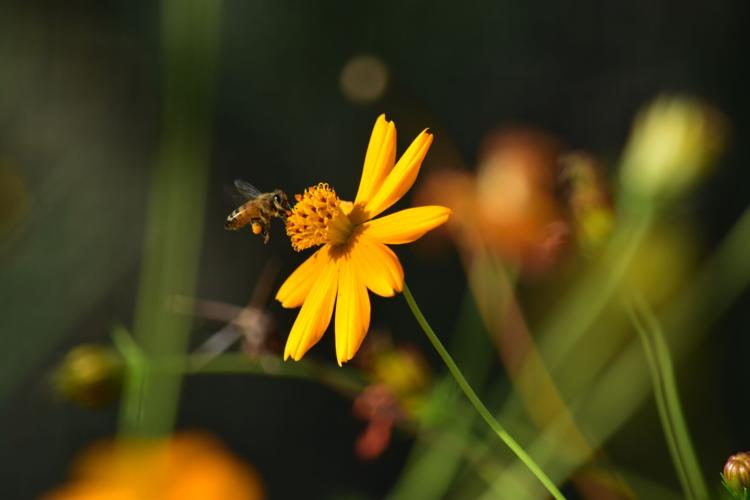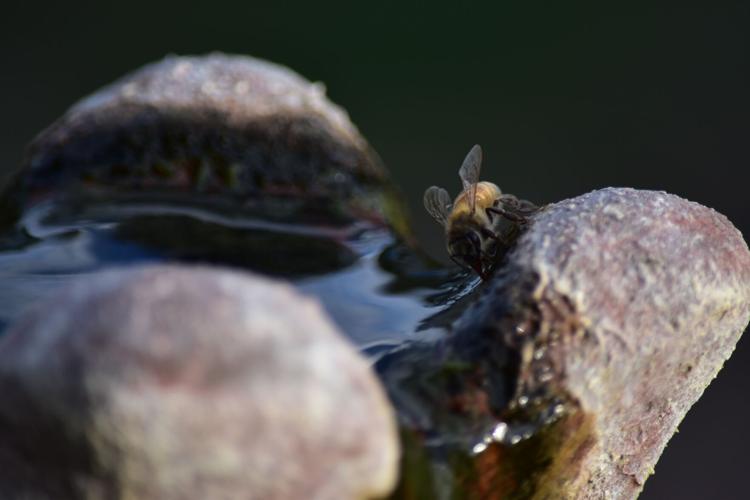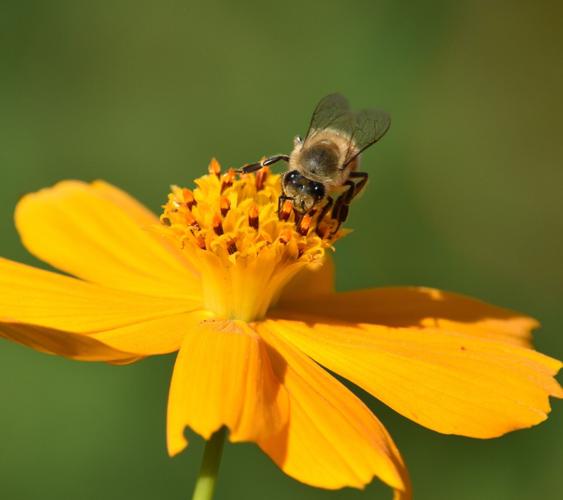With all of Tucson’s lovely desert blooms, you no doubt have noticed plenty of bees. If you want to have a garden with beautiful flowers (and who doesn’t?), you will also have bees and other pollinators.
After a wet spring and fabulous bloom, Tucsonans can expect more wild honeybee swarms and new nests, according to Monica King, a third generation Tucson beekeeper who rescues wild honeybees and rehabilitates them into productive honey producers.
“Anytime we've had a good blossom going on, the bees are packing it in, they're bringing home all kinds of reserves. Their mom, the queen bee, is making a bunch of babies. And so they overgrow their location,” says King. The queen leaves behind her daughter with the old colony and takes about half the colony and flies out to look for a new nest location. King says that Arizona has an average of 18 colonies of wild honeybees per square mile.

A honeybee on a flower gathering pollen and nectar. Worker bees like this one live for only a few weeks.
All of this sounds quite alarming, particularly due to the media hype present around Africanized bees. For perspective, Africanized bees kill about four to five people per year in the US while cows kill around 22 people per year. Nobody’s running around screaming about killer cows, though.
Of course, if you or a loved one is one of the unlucky 3% of people to have an anaphylactic reaction to bee venom, bees can be very problematic, and even life-threatening. For the rest, however, bees are usually of little concern, and we go about our lives without ever noticing these tiny remarkable creatures.
That lack of awareness can be a problem in Arizona, and other areas of the southern United States, due to the known presence of Africanized honeybees in our area. These wild honeybees have been present in Arizona since the early 1990s after being accidentally released in Brazil in 1957.
An Africanized honeybee is one that has the genetics of African wild honeybees (Apis mellifera scutellata) combined with genes from European honeybee subspecies (like A. m. liguistica, the most common subspecies in the U.S.). Honeybees with these genes are more aggressive when defending their nest. That is what makes them dangerous to humans, pets and livestock. The sting of an individual Africanized honeybee is the same as one from a European bee, but the Africanized bees attack in large numbers and will chase their target up to a quarter of a mile. This can result in hundreds of stings, which can kill people and animals.
Honeybees are all non-native species. They are either domesticated European honeybees (being kept and cared for by humans in exchange for honey, beeswax, etc) or wild. Honeybee colonies consist of a queen, who lives for several years and lays the eggs. The majority of the colony’s bees consist of worker bees, who clean up the hive, take care of baby bees, and go out to forage for food and water. These worker bees are all female. There are also male honeybees, called drones, whose existence is focused solely on mating with a queen. They cannot sting or gather food, and need to be fed by worker bees. The act of mating kills them. The chief function of drones is to provide the colony with genetic diversity.
According to research done by the USDA, at least 98% of wild honeybee nests in the Grand Canyon area were found to have African honeybee genes. Research in Texas found similar numbers. Tucson beekeepers who relocate wild honeybees also agree: nearly all of the wild honeybees in Arizona are Africanized, and any wild honeybee nest should be treated with extreme care.
An adventure with Africanized bees
I recently had an encounter with some wild honeybees in my own yard. I found a few bees going in and out of a cubbyhole in a headboard I was storing outside. The cubbyhole wasn’t very big and I could only see a handful of bees, so I assumed there weren’t very many in there. I was tempted to open the cubby and take a look, but I was aware of the risk of attack, so I called up King, who rescues and relocates wild honeybees. Her student, Jolene Sanchez, came that night with her family to remove the bees and relocate them, using a nifty shopvac setup attached to a bee box.
Once it got completely dark, they put on their protective suits, got out their red lights (white light draws the bees to you and upsets them) and started vacuuming. I was not present for that portion of the operation, due to the risk of being swarmed and stung.
It turned out my bees were extremely aggressive, and had built a large honeycomb in the cubbyhole. Sanchez estimated there were about 20,000 bees there, and the honeycomb they removed must have weighed at least 5 pounds.
Watch as an Africanized wild honeybee colony in Tucson gets safely removed and relocated to a new safe place. Video by Dominika Heusinkveld
Once the bees were safely in their box, I came out to take a look. The angry buzzing was definitely alarming, and Sanchez reported that she and her family members got stung many times during the process. The most remarkable thing, though, was the sweet smell I noticed near the bee box. Sanchez told me this was the scent of the pheromone the bees release that tells their sisters to help them drive off the threat to their nest.
It was an amazing glimpse into the lives of these intelligent and organized insects. Recent research shows that honeybees can recognize human faces, and have remarkable spatial and visual memories. They also seem to be able to experience PTSD. Scientists, including the University of Arizona’s pollination ecologist Stephen Buchman, have even argued that they are sentient.
I learned that night that you should never approach or (heaven forbid) open a suspected wild honeybee nest. A layperson can’t tell Africanized honeybees apart from more docile honeybees. They are a little bit smaller than domesticated European honeybees, but this is only apparent when you’re actually catching and measuring them. Any wild honeybee nest or swarm found in Arizona should be assumed to be Africanized and potentially dangerous.
You also likely won’t be able to tell whether the bee in your garden is a honeybee or a native solitary bee – more on those in an upcoming article. However, if you’re really into bee watching, you can check out this great guide to Arizona bee identification.
My aggressive bees ended up going to Monica King’s property for rehabilitation, so they don’t pose a threat to anyone. She lives in a very sparsely populated part of town, and can give the bees the space and time they need to be converted to a more docile colony. This is done by removing the existing queen and replacing her with a more docile European queen. The eggs she lays will result in calmer bees. The previous aggressive worker bees only live for about four to five weeks, so the colony will naturally change over into a docile group.
Keeping feral honeybees away from people

Beekeepers shared advice with community members on how to support Arizona’s bees during the Arizona Honeybee Festival in November organized by the Arizona Backyard Beekeepers Association.
To safely remove bees from your property you will need an expert like King. She and her students remove bees for a fee, and incorporate them into their beekeeping. You can find a bee expert who will relocate bees for you on the website of the Southern Arizona Beekeepers Association (SAZBA).
Will Fitz, president of SAZBA, says people without any experience should not try to remove or relocate bees without help. “Don't try and DIY your way through an Africanized bee colony. It's something that really can turn on you pretty quickly. It's best to leave it to somebody who's got experience and all the right protective equipment,” he says.
King also offers home visits to evaluate your property for wild honeybee colonies, and to point out places that they might take up residence. Wild honeybees like dark, cozy cavities with small entrances, and she has seen bees take up residence inside walls, under soffits and sheds, inside irrigation boxes, in composting bins, in chicken coops, old tires and junk piles. They can also simply set up a nest in an open area, like on a tree limb.
“Africanized bees are well known to do open air hives. And open air hives is where they just decide, hey, this is a great spot. We're gonna make a home right here. And they start creating comb and instead of them just arriving and staying up to 72 hours they overextend their stay and they just start growing,” says King.
King also offers the option of putting up swarm lure boxes, bee-attracting structures that lure honeybees into a controlled space for easy removal. These are a good option for properties that have the potential for lots of wild honeybee nesting and activity.
Fees for wild honeybee colony removal vary. Sometimes a bee relocation is as easy as cutting off a tree branch and placing the nest and colony into a box, says Sanchez. Other times, ladders and specialized vacuums are involved. The best strategy is to prevent bees from making a nest in an awkward place.
“I just tell everybody a big thing is making sure that your house is caulked up, sealed up, 'cause one of the favorite places are soffits and scuppers. They get into the scupper and then go up into the parapet,” says King.
We should all be more aware of bees in our area, as well. “It's basically looking for flight patterns, flight zones," Says King. "Like if you see a lot of bees going in and out of an area, then you know that there could possibly be an issue. It's basically just being really aware of your surroundings. I mean, people look for rattlesnakes, why not look to see if they have bees?”
If you want to learn more about honeybees and beekeeping, consider becoming a member of SAZBA. “You don't even have to be a beekeeper,” says Sanchez, “but you could go to our meetings and just see what's going on in the bee world and the bee community.”
Staying safe around wild honeybees
Here are some additional basic safety precautions to make sure you don’t have an unfortunate encounter with these animals.
- Be aware of your surroundings. Look for bees flying into the same area. If you notice a large number of bees in an area of your yard, consider calling in a bee expert to look for a colony.
- Never try to deal with a wild bee colony yourself. Call an expert.
- Keep people and pets away from the colony and do not use power tools in the vicinity. Consider putting out a sign warning your neighbors.
- Protect your house and property from encouraging wild bees. Close up small holes and cavities, clean up junk and make sure unused vehicles (like RVs) are firmly sealed up. Common places are soffits, under houses and sheds, irrigation boxes, water valve boxes and compost bins.
- If you encounter a large number of bees, stay calm. Do not swat at them. Do not make noise. Call a local beekeeper to remove them safely.
- If a swarm is attacking you, run quickly and try to get indoors as fast as possible. Cover up your eyes and face to avoid getting stung there. Do not jump into water. The bees will just wait for you to resurface.
- If stung, remove the stinger by scraping it off with something flat and stiff, like a credit card. Do not pick it out — this will inject more bee venom into your skin.

This honeybee is drinking water to bring back to the colony. Providing rocks and pebbles around the edge allows bees to access water safely.
How to help Honeybees
- Leave out safe water sources. A small dish with pebbles and rocks allows bees to safely perch when they’re getting a drink. Honeybees use water not only for drinking but to help cool off the nest when it’s hot.
- Plant a variety of native flowering plants that bloom throughout the year.
- Move your hummingbird feeders around so they don’t attract swarms.
- Protect your house and property from wild bee colonies.
- Pay attention to your surroundings and call a beekeeper if you see a colony.
- Support local beekeepers. Bees need a lot of sugar water to keep going during months when few flowers are blooming. You can also donate money to help the relocated bees get through rough times.
- Learn more about bees — see resources below.
- Avoid pesticides. These harm small animals of many species and contribute to Colony Collapse Disorder in honeybees.








